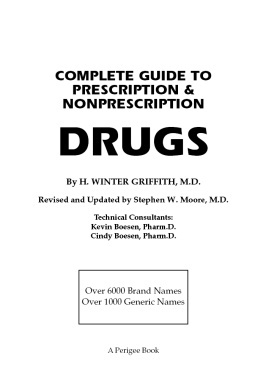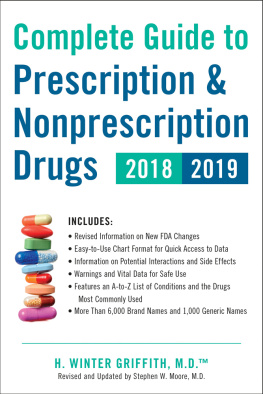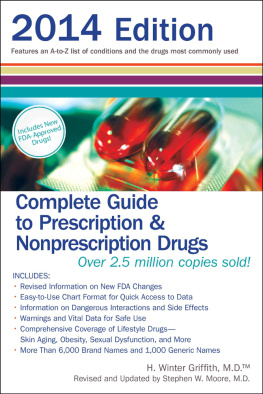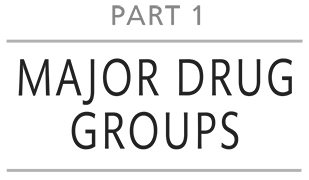This part consists of profiles of 270 key drugs. Each profile gives detailedinformation and practical advice and is intended to provide reference and guidancefor non- medical readers taking drug treatment. It is impossible, however, to takeinto account every variation in individual circumstances; readers should alwaysfollow a doctors or pharmacists instructions where they differ fromthe advice in this section.
The drugs have been selected to provide representative coverage of the principalclasses of drugs in medical use today. For some disorders, a number of drugs areavailable and the most commonly used drugs have been chosen. Emphasis has also beenplaced on the drugs likely to be used in the home, although in a few cases drugsadministered only in hospital have been included when the drug has been judged to beof sufficient general interest.
How to Understand the Profiles
For ease of reference, the information on each drug is arranged in a consistentformat under standard headings.
Drug name Tells you the drugs generic name, brand names under which the drug ismarketed, and combined preparations that contain the drug.
Quick reference Summarizes important facts regarding the drug.
General information Gives a brief summary of the drugs important characteristics.
Information for users Practical information on how and when to take the drug, the usual recommendeddosage, how soon it takes effect, how long it is active, and advice on diet,storage, and missed doses.
Overdose action Indicates the symptoms that may occur if an overdose has been taken and tellsyou what immediate action is required.
Possible adverse effects Indicates adverse effects that may be experienced with the drug.
Interactions Tells you how the drug may interact with other drugs or substances taken atthe same time.
Special precautions Describes circumstances in which the drug should be taken with special cautionor in which it might not be suitable.
Prolonged use Tells you what effects the drug may have when taken long term and whatmonitoring may be advised.
Part 3: Drug finder and Index
The combined drug finder and index provides basic information on over 2,500generic and brand-name drugs and drug groups and directs you to further informationabout them throughout the guide.
Subdivided into sections dealing with each body system (such as heart andcirculation) or major disease grouping (such as malignant and immune disease), this partof the guide contains descriptions of the principal classes of drugs (such as corticosteroids), with information on the uses, actions, effects, and risks associated with eachgroup of drugs. Individual drugs common to each group are listed to allowcross-reference to .
BRAIN AND NERVOUS SYSTEM
The human brain contains more than 100 billion nerve cells (neurons). These nervecells receive electrochemical impulses from everywhere in the body. They interpretthese impulses and send responsive signals back to various glands and muscles. Thebrain functions continuously as a switchboard for the human communications system.At the same time, it serves as the seat of emotions and mood, of memory,personality, and thought. Extending from the brain is an additional, largerod-shaped cluster of nerve cells that forms the spinal cord. Together, these twoelements comprise the central nervous system.
Radiating from the central nervous system is the peripheral nervous system, whichhas three parts. One branches off the spinal cord and extends to skin and musclesthroughout the body. Another, in the head, links the brain to the eyes, ears, nose,and taste buds. The third is a semi-independent network called the autonomic, orinvoluntary, nervous system. This is the part of the that controlsunconscious body functions such as breathing, digestion, and glandularactivity.
Signals traverse the nervous system by electrical and chemical means. Electricalimpulses carry signals from one end of a neuron to the other. To cross the gapbetween neurons, chemical neurotransmitters are released from one cell to bind on tothe receptor sites of nearby cells. Excitatory transmitters stimulate action;inhibitory transmitters reduce it.
What can go Wrong
Disorders of the brain and nervous system may manifest as illnesses that showthemselves as physical impairments, such as epilepsy or strokes, or mental andemotional impairments (for example, schizophrenia or depression).
Illnesses causing physical impairments can result from different types ofdisorder of the brain and nervous system. Death of nerve cells resulting frompoor circulation can result in paralysis, while electrical disturbances ofcertain nerve cells cause the seizures of epilepsy. Temporary changes in bloodcirculation within and around the brain are associated with migraine.Parkinsons disease is caused by a lack of dopamine, a neurotransmitterthat is produced by specialized brain cells.
The causes of disorders that trigger mental and emotional impairment are notknown, but these illnesses are thought to result from the defective functioningof nerve cells and neurotransmitters.
Why Drugs are Used
By and large, the drugs described in this section do not eliminate nervoussystem disorders. Their function is to correct or modify the communication ofthe signals that traverse the nervous system. By doing so they can relievesymptoms or restore normal functioning and behaviour. In some cases, such asanxiety and insomnia, drugs are used to lower the level of activity in thebrain. In other disorders (depression, for example) drugs are given to encouragethe opposite effect, increasing the level of activity.
Drugs that act on the nervous system are also used for conditions thatoutwardly have nothing to do with nervous system disorders. Vomiting, forexample, may be treated with drugs that directly affect the vomiting centre inthe brain or block stimulatory nerve signals to the vomiting centre.
Autonomic Nervous System
The autonomic, or involuntary, nervous system governs the actions of themuscles of the organs and glands. Such vital functions as heart beat anddigestion continue without conscious direction, whether we are awake orasleep.
The autonomic nervous system is divided into two parts, the effects of onegenerally balancing those of the other. The sympathetic nervous system has anexcitatory effect. For example, it widens the airways to the lungs, increasesthe heart rate, and increases the flow of blood to the arms and legs. Theparasympathetic system, by contrast, has an opposing effect. It slows the heartrate, narrows the large airways, and redirects blood from the limbs to thegut.










